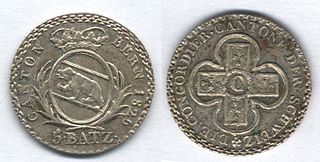| 20 francs | |
|---|---|
 | |
| Coat of arms. POST TENEBRAS LUX | REP• ET CANT/DE GENEVE` 20/FRANCS/1848 |
| AV, 7.62 g, 6h | |
The franc was the currency of the Swiss canton of Geneva between 1839 and 1850. It was subdivided into 100 centimes.
| 20 francs | |
|---|---|
 | |
| Coat of arms. POST TENEBRAS LUX | REP• ET CANT/DE GENEVE` 20/FRANCS/1848 |
| AV, 7.62 g, 6h | |
The franc was the currency of the Swiss canton of Geneva between 1839 and 1850. It was subdivided into 100 centimes.
The franc replaced the thaler in 1839. It was equal to the French franc. In 1850, the Swiss franc was introduced, with 1 Swiss franc = 1 Geneva franc.

Billon coins were issued in denominations of 1, 2, 4, 5, 10 and 25 centimes. Small numbers of coins were struck in silver for 5 and 10 francs and in gold for 10 and 20 francs.

The Swiss franc is the currency and legal tender of Switzerland and Liechtenstein. It is also legal tender in the Italian exclave of Campione d'Italia which is surrounded by Swiss territory. The Swiss National Bank (SNB) issues banknotes and the federal mint Swissmint issues coins.

The Djiboutian franc is the currency of Djibouti. Its ISO 4217 currency code is DJF. Historically, it was subdivided into 100 centimes.
The franc was the currency of French Morocco from 1921. It became the currency of all Morocco in 1957 and circulated until 1974. It was divided into 100 centimes.

The franc was the currency of Cambodia between 1875 and 1885. It was equal to the French franc and was similarly subdivided into 100 centimes. It circulated alongside the piastre with 1 piastre = 5.37 francs. It replaced the tical and was replaced by the piastre. No paper money was issued.

The franc was the currency of Algeria between 1848 and 1964. It was subdivided into 100 centimes.

The franc was the currency of Tunisia between 1891 and 1958. It was divided into 100 centimes (صنتيم) and was equivalent to the French franc.
The franc was the currency of French Cameroun. It was subdivided into 100 centimes and was equal in value to the French franc.

The Frank was the currency of the Swiss canton of Aargau between 1798 and 1850. It was subdivided into 10 Batzen, each of 4 Kreuzer or 10 Rappen. It was worth 1⁄4th the French silver écu or 6.67 g fine silver.
The Basel frank was the currency of the Swiss canton of Basel between 1798 and 1850. It was worth 1⁄4th the French silver écu or 6.67 g fine silver.

The Frank was the currency of the Swiss canton of Berne between 1798 and 1850. It was subdivided into 10 Batzen, each of 10 Rappen. It was worth 1⁄4th the French silver écu or 6.67 g fine silver.
The Frank was the currency of the Swiss canton of Fribourg between 1798 and 1850. It was subdivided into 10 Batzen, each of 4 Kreuzer or 10 Rappen. It was worth 1⁄4th the French silver écu or 6.67 g fine silver.
The Geneva thaler was a coin equivalent to the French silver écu, containing 26.67 g fine silver and valued at 123⁄4florins, which was issued by Geneva until 1798 and between 1813 and 1839.
The Frank was the currency of the Swiss canton of Graubünden between 1798 and 1850. It was subdivided into 10 Batzen, each of 6 Bluzger. It was worth 1⁄4th the French silver écu or 6.67 g fine silver.
The Frank was the currency of the Swiss canton of Solothurn between 1798 and 1850. It was subdivided into 10 Batzen, each of 4 Kreuzer or 10 Rappen. It was worth 1⁄4th the French silver écu or 6.67 g fine silver.
The Frank was the currency of the Swiss canton of Thurgau between 1798 and 1803. It was subdivided into 10 Batzen, each of 4 Kreuzer. It was worth 1⁄4th the French silver écu or 6.67 g fine silver.
The franc was the currency of Togo. Between 1924 and 1956, coins specifically for use in Togo were issued. Since 1945, Togo uses the West African CFA franc.
The franc is the currency of New Caledonia and Wallis and Futuna, part of the CFP franc since 1945 and issued by the Institut d'émission d'outre-mer (IEOM) in Paris. It is subdivided into 100 centimes, although centime denominations are no longer in circulation.
The franc is the currency of French Polynesia, part of the CFP franc since 1945 and issued by the Institut d'émission d'outre-mer (IEOM) in Paris. It is subdivided into 100 centimes, although centime denominations are no longer in circulation.

The franc was the currency of French West Africa. The French franc circulated, together with distinct banknotes from 1903 and coins from 1944. It was replaced by the CFA franc in 1945.

The coins of the Swiss franc are the official coins used in Switzerland and Liechtenstein. The name of the subunit is centime in French and internationally, Rappen in German, centesimo in Italian, and rap in Romansh. There are coins in denominations of 5 centimes, 10 centimes, 20 centimes, 1⁄2 franc, 1 franc, 2 francs, and 5 francs.